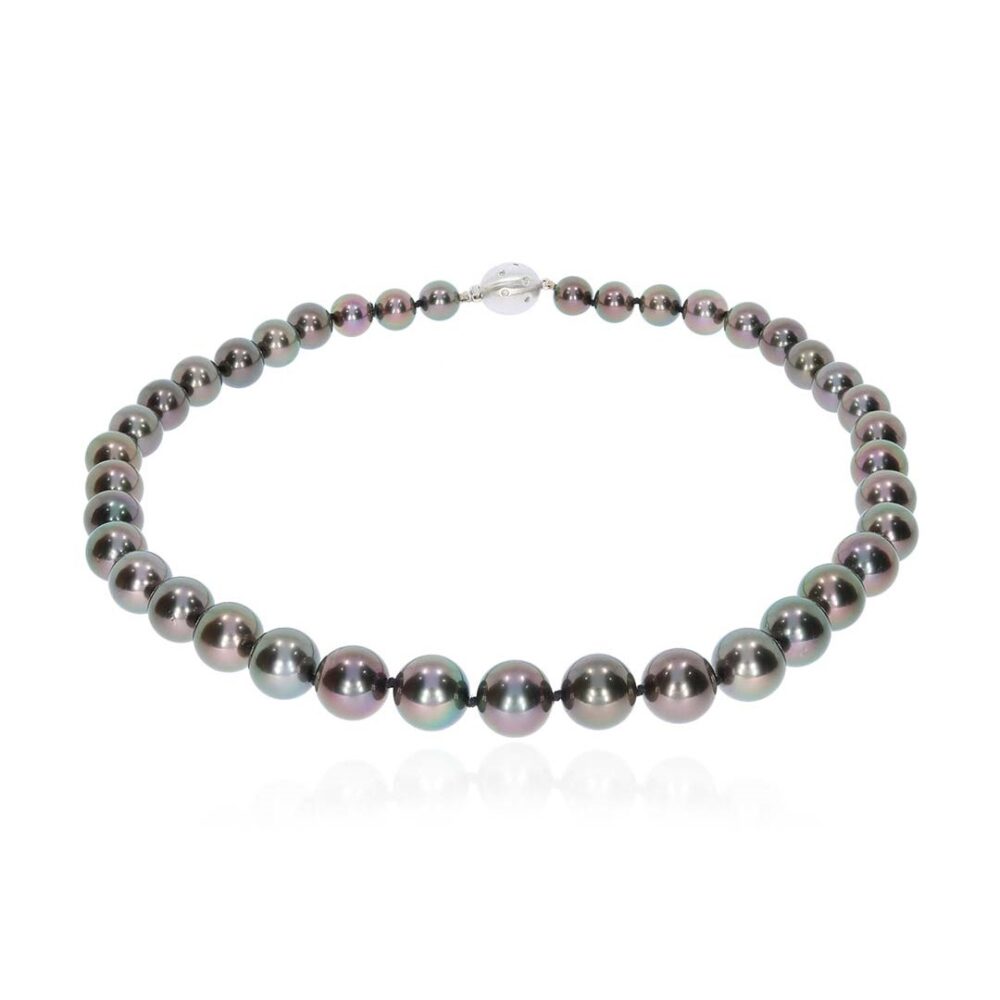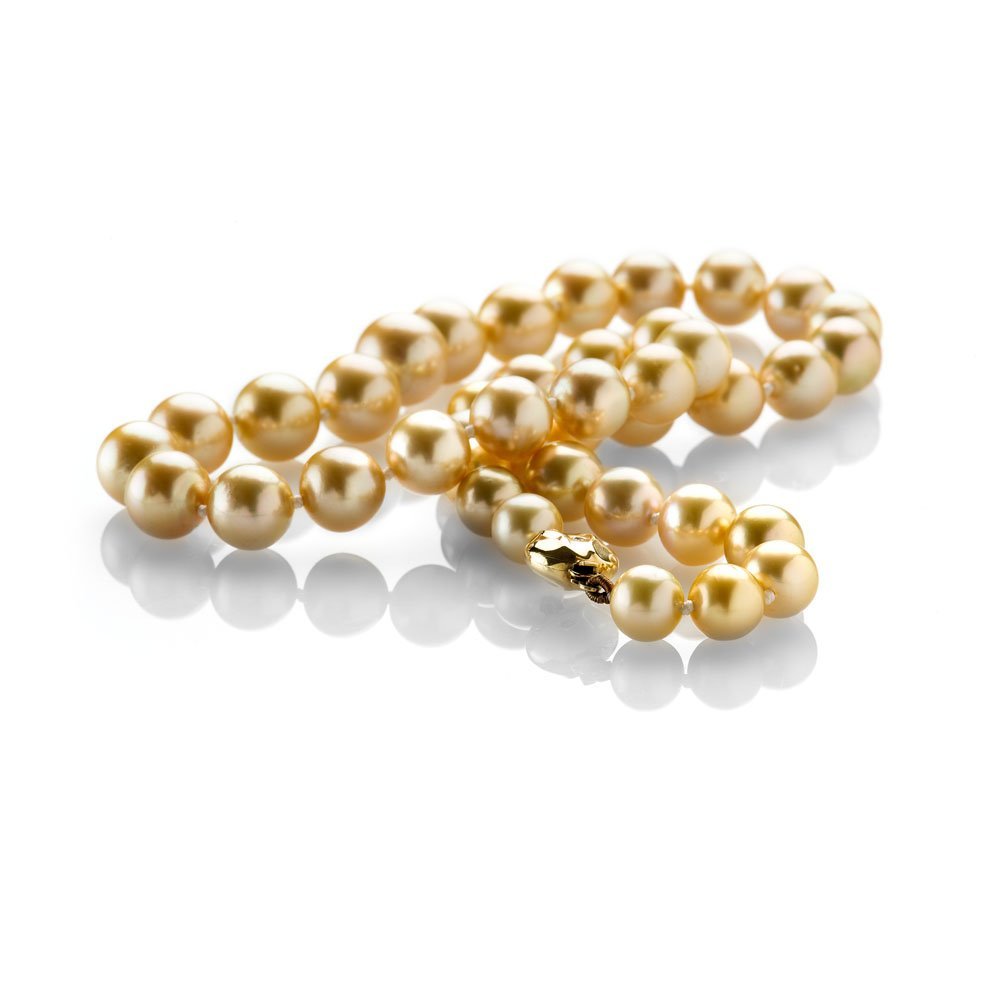The ultimate guide to Pearl Necklaces
The ultimate guide to Pearl Necklaces
Can pearl Necklaces get wet?
Ideally not. Pearls are porous and are made up of concentric layers of Nacre and Conchiolin, an organic compound similar to horn. Moisture causes these layers to swell and eventually lose their lustre and “die”. If pearls have an excessive build up of grease etc. we would recommend having them cleaned professionally and we do offer this service. Also, the chemicals in swimming pools can quickly damage pearls so we would not recommend swimming in them at all. Even though pearls originate in mollusks, which live in either freshwater or seawater, pearls are an internal growth within the mollusk and are not therefore subjected to variations of temperature, acidity and chemical exposure that we would subject a pearl to if we immersed it in water.
If a necklace of pearls is made wet then the silk on which they have been strung, usually with knots, will become wet and remain damp inside the pearl and especially on the knots where the drill hole is. This can hasten the demise of the pearl and the silk itself and cause the pearl to lose lustre and become dull. A damp, warm environment is perfect for the growth of bacteria and these will respire, give off CO2 which is acidic, as per acid rain, and will start to dissolve the pearl. That is why it is very important to have your pearls restrung regularly, especially if you wear them a lot. We always recommend applying make-up, perfume and body lotions first and then put on your pearls last. When you have finished wearing them, a gentle wipe with a soft cloth is all that is required before placing them back in a jewellery box. They are relatively soft, only 3-3.5 on the Moh’s scale of hardness so they will be scratched by metal and other gemstones if they are left amongst other jewellery.
Are pearl necklaces valuable?
They can be extremely valuable, depending on the type, size, smoothness of the surface, lustre, and colour of pearl which all affect their quality and so value. Recently some natural Pearls came in to us for valuation. We decided that they needed to be investigated so they went to be certificated in the Gem laboratory in London and the happy outcome was that they were natural. Their value was huge, close to six figures! Cultured South Sea and Tahitian pearls are the most valuable pearl necklaces, followed by Akoya cultured pearls (a brand similar to Mikimoto) and then finally cultured freshwater pearls. Each type of pearl has all the ranges of quality so gem-quality, expensive freshwater pearls are possible and also cheap South Seas and Tahitians if their quality is not so good. The clasp may add interest and value as well so this is an important consideration when purchasing a pearl necklace.
How are pearl necklaces made?
Pearls today are in the main cultured or farmed. In the case of seawater pearls be they South Sea (You searched for south sea – Heidi Kjeldsen), Tahitian (You searched for tahitian – Heidi Kjeldsen) or Akoya (You searched for akoya – Heidi Kjeldsen), a small mother of pearl (shell) bead is inserted into the live mollusk. The mollusk encapsulates this intruder and begins to lay down layers of calcium carbonate (nacre) and conchiolin in an endeavor to make it as round and smooth as possible. After several years the pearls are harvested and then matched in size, colour, luster to make the perfect pearl necklaces you can buy today. Freshwater pearls (Margit Large Cultured Pearl Necklace – Heidi Kjeldsen) are cultivated in a slightly different way and they can produce several pearls inside one mollusk and this perhaps makes them more affordable.
Once harvested and graded the pearls are drilled. The drill holes are as small as possible as pearls are usually sold wholesale by “momme” or weight so the smaller the drill hole the heavier the pearl. The drilled, graded and matched pearls are then strung onto a wire or silk for selling to the jewellery trade. The pearls are then purchased and strung with clasps, usually onto silk with knots and with a desirable clasp. Heidi personally does all the pearl stringing as she has done this for almost 30 years, and has the skill set and the experience to do this professionally and charges accordingly for the service.
Which pearl necklace to buy?
The type of pearl necklace you decide to buy depends on preference, budget and style and also the type of pearl. South Seas are expensive, large, lustrous and make a real statement. They are available in various hues of white as well as Golden South Seas which are rare and highly regarded. Tahitian Pearls Grete Tahitian Pearl Necklace (heidikjeldsen.co.uk) are also large and usually grey, green or black. These are luxurious and look beautiful teamed with a simple pair of matching Tahitian earstuds (Grete Tahitian Pearl White Gold Earstuds – Heidi Kjeldsen) or even a dress ring (Grete Tahitian Pearl and Diamond Ring (heidikjeldsen.co.uk)). Akoya Cultured Pearls (Margit Akoya Cultured Pearl Necklace (heidikjeldsen.co.uk))are seawater pearls with a gorgeous lustre and pinkish/white hue. Dyed pearls (Lisbet Black Coin Pearl Necklace (heidikjeldsen.co.uk))are also popular, this colour enhancement is permanent and often adds a different dimension to the pearls giving an iridescent sheen which can be stunning. The more affordable pearls are cultured freshwater pearls which do come in various colours depending on what the creature has been eating! They may also be dyed and again this can result in some beautiful and unusual colourways.
Pearl necklaces vary in length. The usual is 16″ or 18″ but a long opera length row of lustrous white pearls is elegant and such a classic look. Chokers are on trend with celebrities sporting all varieties of pearl chokers and they look stunning. Enhancers (Grete Tahitian Pearl and Diamond Clip-On Enhancer (heidikjeldsen.co.uk)) are another way to bring variety to your row of pearls and adding a sumptuous black or white pearl to a row of pearls is a stylish way to alter the whole look.
Clasps add the finishing touch to the pearl necklace, they may have integral safety features or may be simple magnetic clasps if they are easier for the client to manage. Diamond and gemstones may be set into the clasps or they may be interchangeable all are possible options. Which pearl necklace to buy?
Why buy a pearl necklace?
A pearl necklace is a classic piece of jewellery, which never seem to go out of style. At the moment they are making a comeback, with royalty, superstars and fashionistas, they seem to be loved by all once again. Pearls may be your signature piece, expressing your individuality in a beautiful, elegant way. For example, paired with a monochrome ensemble they will carry you from work to the evening. Simple necklaces are easy for everyday wear, more elaborate chokers and long necklaces make stunning evening attire. Change your style by adding different colours of pearl and shapes for a more on trend look which is less classical but equally beautiful.
Pearl necklaces are often gifted for special occasions and as such are treasured for a lifetime and passed on as heirlooms if particularly high grade. The joy they bring and the way they illuminate the face make them a must have for most people. They may be an investment if looked after well and if they are high grade pearls to begin with.
